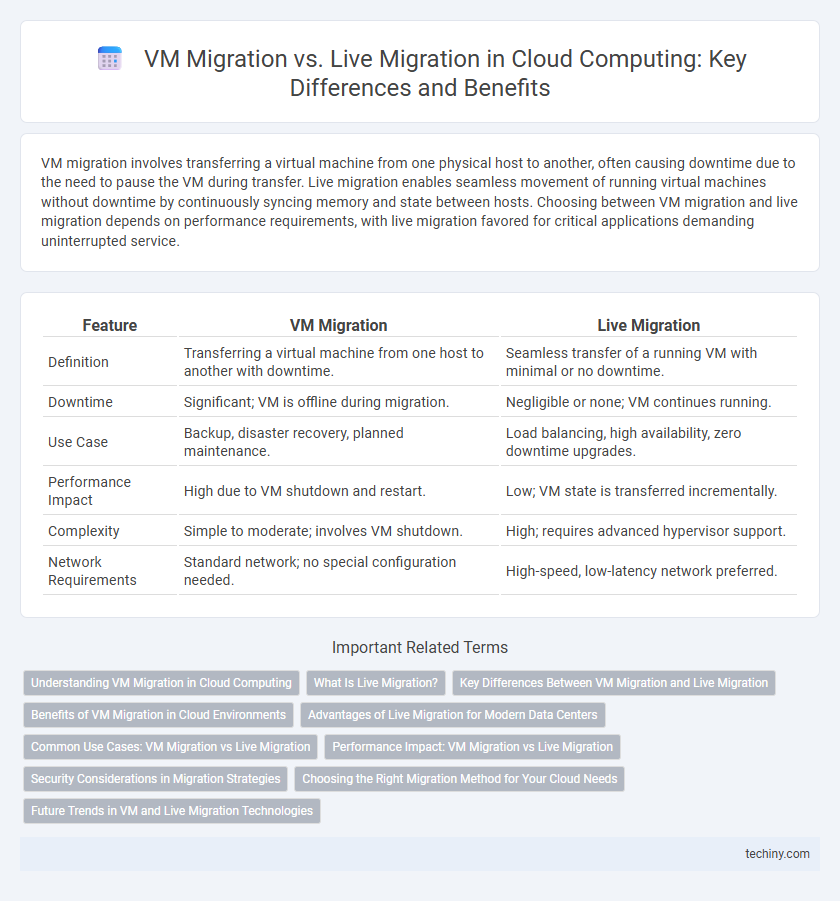VM migration involves transferring a virtual machine from one physical host to another, often causing downtime due to the need to pause the VM during transfer. Live migration enables seamless movement of running virtual machines without downtime by continuously syncing memory and state between hosts. Choosing between VM migration and live migration depends on performance requirements, with live migration favored for critical applications demanding uninterrupted service.
Table of Comparison
| Feature | VM Migration | Live Migration |
|---|---|---|
| Definition | Transferring a virtual machine from one host to another with downtime. | Seamless transfer of a running VM with minimal or no downtime. |
| Downtime | Significant; VM is offline during migration. | Negligible or none; VM continues running. |
| Use Case | Backup, disaster recovery, planned maintenance. | Load balancing, high availability, zero downtime upgrades. |
| Performance Impact | High due to VM shutdown and restart. | Low; VM state is transferred incrementally. |
| Complexity | Simple to moderate; involves VM shutdown. | High; requires advanced hypervisor support. |
| Network Requirements | Standard network; no special configuration needed. | High-speed, low-latency network preferred. |
Understanding VM Migration in Cloud Computing
VM migration in cloud computing involves transferring a virtual machine from one physical host to another to optimize resource utilization, enhance load balancing, or perform hardware maintenance. This process can be classified into offline migration, where the VM is powered down during transfer, and live migration, which enables the VM to move without downtime, maintaining continuous service availability. Understanding the distinctions between these migration types is crucial for designing efficient cloud infrastructure and minimizing service disruption.
What Is Live Migration?
Live migration in cloud computing refers to the seamless transfer of a virtual machine (VM) from one physical host to another without downtime or service interruption. This process involves continuously copying the VM's memory and system state while the VM remains operational, ensuring minimal impact on application performance. Live migration enhances resource management, load balancing, and fault tolerance in virtualized environments by allowing dynamic workload redistribution.
Key Differences Between VM Migration and Live Migration
VM Migration involves transferring a virtual machine from one host to another, which typically requires shutting down the VM, causing downtime. Live Migration allows the virtual machine to move between hosts without interrupting its operation, maintaining continuous availability and minimal service disruption. Key differences include downtime risk, process speed, and impact on user experience, with live migration optimized for high-availability environments.
Benefits of VM Migration in Cloud Environments
VM migration in cloud environments enhances resource optimization by enabling dynamic workload distribution across physical servers, reducing bottlenecks and improving overall system performance. It facilitates maintenance and upgrades without significant downtime, increasing service availability and minimizing operational disruption. This flexibility supports scalability in cloud infrastructure, allowing seamless adaptation to changing demand and efficient utilization of computing resources.
Advantages of Live Migration for Modern Data Centers
Live migration enables seamless VM transfer between physical hosts without downtime, preserving application availability and user experience in modern data centers. It optimizes resource utilization by facilitating workload balancing and hardware maintenance without service disruption. This real-time mobility enhances disaster recovery strategies and supports dynamic scaling in cloud environments.
Common Use Cases: VM Migration vs Live Migration
VM migration is commonly used for planned maintenance, data center relocation, and load balancing, involving downtime since the virtual machine is powered off during the transfer. Live migration supports real-time workload mobility without service interruption, making it ideal for high-availability environments, disaster recovery, and dynamic resource scaling. Both techniques enhance cloud infrastructure flexibility but differ in operational impact and use case suitability.
Performance Impact: VM Migration vs Live Migration
VM migration involves stopping the virtual machine to transfer its entire state, resulting in noticeable downtime and potential performance degradation. Live migration enables the transfer of a running VM with minimal downtime by continuously synchronizing memory pages, significantly reducing performance impact. Network latency and workload intensity directly influence live migration efficiency, whereas VM migration's performance hit is primarily due to VM stoppage duration.
Security Considerations in Migration Strategies
VM migration and live migration present distinct security challenges in cloud computing environments. VM migration typically involves downtime, increasing the risk of data exposure during the transfer phase, whereas live migration ensures continuous operation but requires robust encryption protocols to protect data in transit. Implementing end-to-end encryption, secure authentication mechanisms, and real-time monitoring are critical to safeguarding virtual machines against interception and unauthorized access during both migration strategies.
Choosing the Right Migration Method for Your Cloud Needs
VM migration involves transferring a virtual machine from one physical host to another, typically requiring downtime, which can impact service availability. Live migration allows the transfer of a running VM with minimal to no downtime, maintaining continuous service and improving user experience. Selecting the right method depends on factors like migration speed, downtime tolerance, workload sensitivity, and infrastructure capabilities within your cloud environment.
Future Trends in VM and Live Migration Technologies
Future trends in VM and live migration technologies emphasize improving migration speed, minimizing downtime, and enhancing resource allocation through AI-driven automation. Advances in edge computing and 5G integration will enable more efficient live migrations across distributed cloud environments, supporting real-time applications and reducing latency. Security improvements such as encrypted migration channels and robust authentication protocols will further protect data integrity during transit.
VM Migration vs Live Migration Infographic

 techiny.com
techiny.com